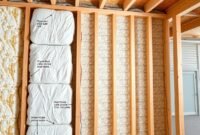What do you think about foam board pole barn insulation for your pole building? If you are curious about this, make sure to learn about it in this article. You will find several materials, including foam board, that you can use to insulate your pole barn.
Understanding the perks of insulating your building with such materials, especially in terms of energy savings and air movement control, is crucial.
Cheap Way to Insulate Pole Barn
So far, there are several materials that we can use to insulate a building, including fiberglass insulation, closed-cell spray foam, and rigid foam board. To mention a few, there is spray foam pole barn insulation, fiberglass, cellulose, and foam board insulation.
Each of these materials offers unique benefits, such as improved structural integrity and energy savings, particularly in metal walls and roofs. Each insulation material will have its suitability when linked to insulating a pole barn.
However, if your budget is a bit limited, understanding the long-term benefits and cost-effectiveness of materials like foam board is crucial to insulating your pole barn effectively.
Foam board insulation, especially when used for insulating the ceiling and walls of a pole building, can provide significant energy savings and enhance indoor air quality.
Otherwise, you will end up having more problems with insulating your building, resulting in you paying more for the insulation process.

So, what is the cheapest way to insulate your pole barn? You can use rigid foam to insulate your pole barn if you want to do it cheaply. Insulating a pole barn with foam board—despite its affordable price, it also comes with several benefits, such as effective air movement control and enhanced structural integrity, which you can admire. More on that in the next explanation.
What is Foam Board Pole Barn Insulation?
Simply put, it is a wall insulation method that involves placing rigid insulation boards on a pole barn. Foam board is a simple-to-use and cheap insulation material, which is perfect if you want thrifty insulation. It can be said to be pretty effective, and the installation process can be done in a DIY project.
In having this material as your insulation, you can pick the thickness you want it to be. As you may have imagined, insulating a pole barn with foam board will affect the amount of money you will pay. The thicker the material, the higher the price you will have to pay.
Read also: Best Adhesive for Foam Board to Concrete
Are you curious about what benefits and drawbacks you can get from this insulation material? Well, here is the explanation.
Pros:
- This material is the cheapest one, and it is easy to install. Even you—a DIY person—can do it all by yourself. The installation process varies depending on the specific needs of your pole building. Still, with the right tools and techniques, foam board insulation can be an effective and budget-friendly solution.
- This foam board insulation product is water resistant, making it an excellent choice for areas where a vapor barrier is necessary. This is a perfect solution for a pole barn which is prone to moisture buildup, which may lead to mildew growth.
- If you pick the expanded polystyrene board, this is the material that is pretty safe for the environment since it doesn’t use HCFC while producing it.
- The expanded polystyrene foam board, a type of rigid foam board, is made from closed-cell foam. This material is perfect for exposed pole barn walls.
Cons:
- If you want to use this insulation method, you need to caulk the joint or even tape it, ensuring compliance with building codes and maximizing efficiency. Why so? This is done to prevent any airflow from entering the building.
- To be readily used as a pole barn insulation, you need to cut the board. For some, this is pretty troublesome as you need to spend time cutting the board and making it fit within the areas.
- Compared to traditional insulating materials that are used in a pole barn, having foam board means you need to allocate more money to this.
- Your foam board may decrease its insulating abilities over time. Hence, you need to occasionally check the insulation to learn whether it needs renewal or not.
- Several types of polystyrene boards have bubbles. The bubbles can make the heat stop getting transferred. However, this kind of material doesn’t expel moisture. Hence, it makes your foam board more prone to mildew and microorganism growth.
Read also: Do Interior Walls Need Insulation?
While foam board insulation offers several advantages for pole barns, it’s important to weigh these against potential drawbacks. Over time, the insulating abilities of foam boards may diminish, requiring periodic checks and maintenance.
Read also: Cheapest Way to Insulate a Pole Barn?
Additionally, some polystyrene boards can be prone to mildew and microorganism growth due to moisture retention. However, with proper installation and maintenance, foam board can be a cost-effective and efficient insulation choice for your pole barn.
Well, that’s the information related to foam board pole barn insulation. What do you think about this material? Will it be a great one for your pole barn?


